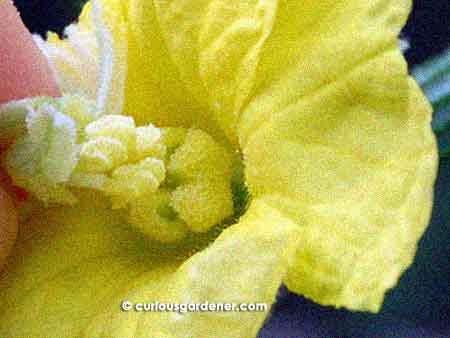The angled loofah plant
blooms in the evening. Its pale yellow cucurbita flowers are easily spotted from a distance – male flowers generally in a bunch, female flowers alone.
I’ve noticed that the blooming flowers attract insects to the plants, particularly ants. These insects can be seen scuttling along stems and around the flower buds, and are the cause of pollination.
Normally, anyway.
They don’t always do their job, especially if the male flowers are a bit too far from the female flowers. At times like that, it’s good to step in and lend a hand.
Hand-pollinating flowers doesn’t have to be a complicated process. Some people recommend using a cotton bud to first swab the male flower to gather pollen, then to swab the female flower to transfer the pollen.
I, on the other hand, like to do things as easily as possible. So, since my plants have several bunches of male flowers, I simply pluck one male flower, strip away the petals, and introduce the male anther to the stigma of the female flower. In other words, gently rub the middle parts of the flowers together to transfer the pollen.
It takes less than a minute, and by the following day, you’ll see the fruit already starting to grow longer. The petals will drop within the next day, and the stigma will dry up at the tip of the fruit as it grows. Harvest within two weeks, before the fruits start getting fibrous. We’ve got several female flowers forming now that our two vines have matured sufficiently. That’s going to be a lotta luffa in a few weeks!
© 2011 curiousgardener.com All rights reserved.



I’ve grown two vines, and wasn’t aware of how I ended up with the one gourd I have until today’s reading. That said, I still have a few questions I hope you can answer.
1. Can pollen be taken from a male flower via cue-tip, and saved until a female flower blooms?
2. You say to harvest them in two weeks, but is there a way to determine readiness by feel?
3. If I’d like to eat some and use others for sponges, how do I determine when a loofah has reached it’s maximum growth length?
4. I’ve only seen male flowers so far, which open in the morning and then fall off and die by the next morning, do the female flowers do the same thing?
5. How do the female flowers differ from the male? I ask for identification purposes because I’m pretty sure I “pollenated” two male flowers yesterday not knowing any better.
Thanks for any tips!!!
Scott
Hi Scott,
It sounds like you’re growing the round loofah. I’ve heard that those flowers bloom in the morning whereas those of the angled loofah – what I grow – bloom in the evening. Both male and female flowers bloom at the same time of day, and last just for those few hours.
Male flowers usually grow in a bunch and look like regular flowers – flower stem holding the flower. Female flowers grow singly and have a miniature fruit behind the flower bud. Take a look at this post.
If I were you and I wanted to try to keep the pollen, I’d pluck the male flower and keep it refrigerated. But, I’m not sure how long the pollen will stay viable. Now that I’ve grown the angled loofah, I know that the vine produces enough male flowers to pollinate the female flowers, so I don’t bother with hand-pollination any more. There are almost always male flowers present, and many insects to do the pollination for me.
My gauge for harvesting the fruits is to feel the fruit. It should have a bit of bounce in it when you gently squeeze it. Once the skin starts hardening, and the ridges of the angled loofah stiffen, it’s time to harvest – quickly! Wait too long and the flesh will be very fibrous and the seeds will be bigger and crunchier. I’m not sure what the signs are for the round loofah, though.
In my experience, each loofah grows to a different size. We’ve had long and really short ones on the same vine. I guess you could leave them on the vine past eating stage and just visually judge whether it’s still growing bigger. As you can tell, I grow mine to eat!
Hope that helps!